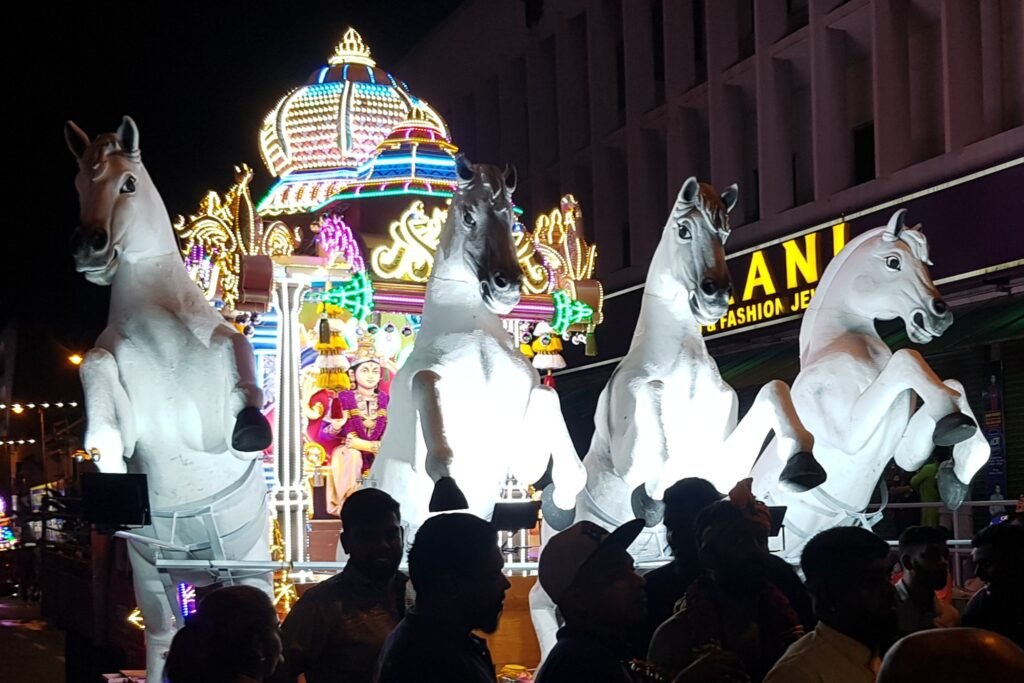
Introduction
If you have ever joined Thaipusam at Batu Caves, you know it is more than a festival. The sound of drums, the sight of devotees carrying kavadi, and the smell of incense in the air create an atmosphere that is hard to forget. This powerful celebration is one of the most iconic in Malaysia, but the story of how it became such an important tradition here goes back more than a hundred years.
The Origins of Thaipusam
Thaipusam began in Tamil Nadu, South India, as a festival dedicated to Lord Murugan, the Hindu god of war and virtue. The word itself comes from the Tamil month of Thai and the star Pusam (Poosam), which align during the full moon.
According to Hindu tradition, Thaipusam marks the day when Goddess Parvati gave Lord Murugan a sacred spear, known as the vel, so that he could defeat the demon Soorapadman. The festival is a symbol of victory of good over evil and of devotion to divine power.
When Tamil immigrants came to Malaya in the 1800s to work in plantations, railways, and trade, they carried this tradition with them. For them, Thaipusam was not only a religious practice but also a way to keep their culture alive in a foreign land.
Thaipusam Arrives in Malaysia
The first recorded Thaipusam celebrations in Malaysia took place in the late 19th century. Small groups of Tamil Hindus gathered in temples they had built in their new communities. Over time, three major temples became central to the festival:
- Batu Caves in Selangor
- Balathandayuthapani Temple (Waterfall Hilltop Temple) in Penang
- Kallumalai Temple in Ipoh
These temples provided a place where the community could come together, pray, and perform rituals of devotion. Batu Caves, with its towering limestone cliffs and natural caves, became especially significant. In 1891, the first wooden temple dedicated to Lord Murugan was built inside the caves. By the early 1900s, Thaipusam at Batu Caves had already become a large-scale festival that drew people from across Malaya.
Growing Into a Major Festival
Through the decades, Thaipusam grew from a community gathering into one of the largest Hindu festivals outside India. The introduction of the kavadi procession made the festival even more striking. Devotees carried wooden or metal frames decorated with flowers, peacock feathers, and images of Lord Murugan as a form of penance and thanksgiving.
British colonial administrators often watched the festival with fascination, sometimes treating it as a cultural spectacle. But for the Tamil community, it was always a sacred act of devotion. By the mid-20th century, Thaipusam had become firmly rooted in Malaysian society.
Thaipusam Today
In modern times, Thaipusam has grown into a celebration that attracts millions of people each year. Batu Caves is the most famous site, with a procession that begins at the Sri Maha Mariamman Temple in Kuala Lumpur and ends at the 272 steps leading up to the cave temple. A towering golden statue of Lord Murugan now stands at the entrance, watching over the celebrations.
Thaipusam is marked by:
- Kavadi processions, where devotees carry heavy, decorated structures as an offering.
- Milk offerings (paal kudam), symbolizing purity and devotion.
- Acts of penance, such as piercing the skin, tongue, or cheeks with small spears, along with fasting and prayers in the days before the festival.
In Penang, Thaipusam has its own unique character, with street processions, cultural performances, and a climb up to the hilltop temple. In Ipoh, the Kallumalai Temple remains a key site for northern Malaysia.
Although Thaipusam is deeply spiritual, it has also become a cultural event that brings together Malaysians of all backgrounds. Tourists, photographers, and curious onlookers gather to witness the festival’s energy and color. Food stalls, music, and community gatherings make it a celebration that is as cultural as it is religious.
Why the History Matters
The history of Thaipusam in Malaysia is not just about a festival. It is about how a community preserved its faith and traditions far from home. It is about how cultural practices can grow, adapt, and become part of a country’s identity.
For the Tamil Hindu community, Thaipusam is a powerful reminder of devotion and sacrifice. For Malaysia as a whole, it is a symbol of multicultural harmony, showing how different traditions can thrive side by side.
Related Articles on Thaipusam
👉 Looking for a breakdown of practices and ceremonies? Explore our article on the Rituals and Practices of Thaipusam.
👉 Curious if Thaipusam is a public holiday in Malaysia? Read our detailed guide here.
👉 Want to understand the deeper meaning behind the rituals? Check out our post on the Significance of Thaipusam.
